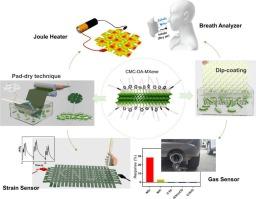Surface functionalized MXene ink-enabled washable smart e-textiles with exceptional gas sensing properties
IF 22
1区 材料科学
Q1 MATERIALS SCIENCE, MULTIDISCIPLINARY
引用次数: 0
Abstract
Electronic textiles (e-textiles) that sense physical stimuli and toxic gases, exhibit Joule heating capabilities, and enable information transmission hold great promise for advancing personalized healthcare. Titanium carbide MXene, Ti3C2Tx (Tx = –OH, –O, –F, etc.), has shown huge potential for creating such e-textiles owing to its two-dimensional morphology, high electrical conductivity, reactive surface characteristics, and facile integration into textiles by solution-based approaches. However, MXene nanosheets’ poor oxidation stability and weak adhesion to textile fibers raise concerns about MXene-based e-textiles’ washing durability. Further, the toxic gas sensing abilities of MXene-based e-textiles have hardly been realized. To overcome these challenges, MXene surface is functionalized with dopamine-conjugated carboxymethyl cellulose ligands (CMC-DA-MXene), which protect MXene from oxidation and initiate strong adhesive interactions with textile fibers. Despite the presence of CMC-DA intercalants, the CMC-DA-MXene nanosheet assemblies maintain good electrical conductivity; as a result, e-textiles exhibited excellent Joule heating and tactile/flex sensing properties. Additionally, the unique ability of CMC-DA ligand to selectively interact with NO2 gas molecules and humidity through the catechol head and carboxymethyl cellulose tail, respectively, enables the incorporation of NO2 and humidity sensing capabilities into CMC-DA-MXene e-textiles. The gas/humidity sensing mechanism is explained using density functional theory calculations. Overall, the results provide a foundation for realizing multifunctional MXene-based e-textiles that are oxidation-resistant and washable.

表面功能化MXene油墨可洗智能电子纺织品具有特殊的气体感应性能
电子纺织品(e-纺织品)能够感知物理刺激和有毒气体,具有焦耳加热能力,并支持信息传输,为推进个性化医疗保健带来了巨大希望。碳化钛MXene, Ti3C2Tx (Tx = -OH, -O, -F等)由于其二维形态,高导电性,活性表面特性以及通过基于溶液的方法易于集成到纺织品中,显示出创建此类电子纺织品的巨大潜力。然而,MXene纳米片的氧化稳定性差,与纺织纤维的附着力弱,引起了人们对MXene基电子纺织品洗涤耐久性的担忧。此外,基于mxe的电子纺织品的有毒气体传感能力几乎没有实现。为了克服这些挑战,MXene表面用多巴胺共轭羧甲基纤维素配体(CMC-DA-MXene)功能化,保护MXene不被氧化,并与纺织纤维产生强的粘合作用。尽管存在CMC-DA插入剂,CMC-DA- mxene纳米片组件仍保持良好的导电性;因此,电子纺织品表现出优异的焦耳加热和触觉/柔性传感性能。此外,CMC-DA配体通过儿茶酚头部和羧甲基纤维素尾部选择性地与NO2气体分子和湿度相互作用的独特能力,使CMC-DA- mxene电子纺织品具有NO2和湿度传感能力。利用密度泛函理论计算解释了气体/湿度传感机理。研究结果为实现多功能耐氧化耐洗mxene纺织品奠定了基础。
本文章由计算机程序翻译,如有差异,请以英文原文为准。
求助全文
约1分钟内获得全文
求助全文
来源期刊

Materials Today
工程技术-材料科学:综合
CiteScore
36.30
自引率
1.20%
发文量
237
审稿时长
23 days
期刊介绍:
Materials Today is the leading journal in the Materials Today family, focusing on the latest and most impactful work in the materials science community. With a reputation for excellence in news and reviews, the journal has now expanded its coverage to include original research and aims to be at the forefront of the field.
We welcome comprehensive articles, short communications, and review articles from established leaders in the rapidly evolving fields of materials science and related disciplines. We strive to provide authors with rigorous peer review, fast publication, and maximum exposure for their work. While we only accept the most significant manuscripts, our speedy evaluation process ensures that there are no unnecessary publication delays.
 求助内容:
求助内容: 应助结果提醒方式:
应助结果提醒方式:


